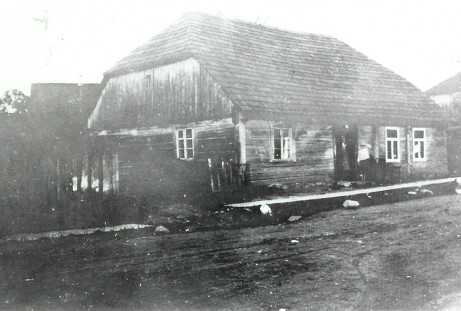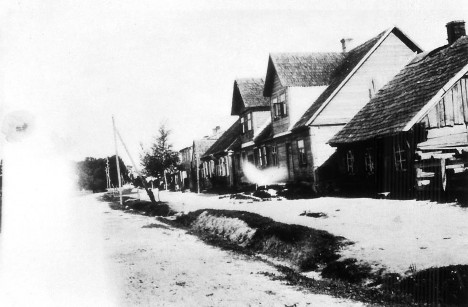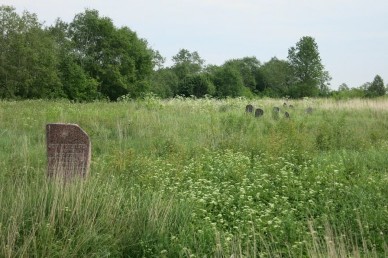
Ben Zion Ganz
In June 2015 my wife and I visited the Akmene-Klikol area of northern Lithuania, hoping I might find some trace or record of my ancestors.
My great-grandfather (my mother’s paternal grandfather), Ben Zion Ganz, was born in Akmene in 1870. He married Marie Lahn, of Klykoliai (Klikol, in Yiddish), and the couple settled in her home town, late in the 19th century.

In about 1901, Ben Zion went to Sweden in search of work, leaving behind his wife and four or five children. He returned to Klikol six years later, when his oldest son, my grandfather Maurice Ganz, was 13. Before long, Ben Zion left again, for Norway, where Jews were newly allowed to settle. This time, he took Maurice with him. At perhaps about the same time, Maria’s uncle Are Ruwen Lahn also moved from Klikol to Norway, and he has many, many descendants there.
Ben Zion worked as a peddler, or traveling salesman, taking young Maurice along with him, though eventually Ben Zion got so sick that Maurice had to peddle all over Norway by himself. Maurice had just three years of Hebrew school education, but he was very smart and often stayed up all night reading. Ben Zion’s father, Louis, was a rabbi, and the children were raised on the Torah. When Maurice and his father traveled around Norway, they stayed in accommodations that usually had one book, the Bible. But on one occasion, as we heard it from Grandpa, there was an atlas of world history in the rented room. He read it from cover to cover and was astonished to learn, among other things, that the world wasn’t, in fact, created 6000 years ago. He was so furious that he had been lied to all these years that he rejected religion altogether.
Meanwhile, the rest of my great-grandparents’ family moved from Lithuania to Norway in about 1913. That included Maria and the couple’s other five children – three sons and two daughters.
By 1914, Maurice left Norway for the USA, with his sister Sonja – the only ones in his immediate family to do so for at least half a century. He married in New York and honeymooned in New Jersey; my mother was born in 1920. She once told me, “I was conceived in New Jersey and I’ll probably die there.” She lived in Jersey from 1968 until her death in 2021.
The family, except for Maurice and Sonja, stayed in Norway until the World War II Nazi occupation changed everything. The three brothers fled to neutral Sweden to join the Norwegian exile resistance army. Their mother, sisters, wives, and children were left behind under the impression that they would be safe. It was not until the brothers returned at the end of the war that they learned that all of their families had been deported to Auschwitz and killed by the Germans – with the exception of Ben Zion, who died of poor health shortly before the deportations.
I was the first of my family or the extended Ganz family, as far as I know, to visit Lithuania since Grandpa Maurice went in 1934. At that time he saw some cousins and reported that they were very poor. We don’t know who they were or what their fate was, but if they stayed in Lithuania, they almost certainly were, like their Norwegian relatives, killed by the Nazis.
Maurice took photos of the family homes of his mother and father. Here are reproductions:


When we visited this year, we started in Žagare, where we had the great fortune to connect with a young local woman, a friend of a friend of a college friend of mine who I last saw over 40 years ago. She oriented us and generously told us about the area’s history.
In Akmene, we went to the museum, where an English-speaking staff person gave us a thorough tour, but had no information on Jewish history. He referred us to the local government building, which houses the police as well as an office of social workers who look after the needs of the young and elderly. We showed the social workers the photo of the Ganz house, and they gave us their full attention in trying to identify where that house might be. With the help of a couple of the town elders, we looked at two possibilities, but alas, they were not the ones. We concluded that the house must no longer exist.
The next day we went to Klykoliai, with the same objectives. It’s a tiny village – maybe a hundred homes, and no retail commerce. From a friend I had heard a description of the old Jewish cemetery there, so we went to look for it. The town is literally right on the border with Latvia, just on the Lithuanian side of the Vadakstis River. (My grandfather had grown up speaking both Lithuanian and Latvian, as well as Yiddish. Later he became fluent in Norwegian and English.) We walked back and forth across the little bridge that crosses the border – surely, Maurice made that same crossing many times.
We expected to find the Klykoliai cemetery right along the river by the bridge, but it wasn’t there. What we did find was a little picnic area, with four Lithuanians enjoying a barbecue. They spoke no English, but we showed them the words we had written down: Žydu Kapines. After a moment’s consultation, they figured out where it was, nearby. Two of them jumped in their car and led us to it, not far to the east, but we never would have found it by ourselves. The cemetery was quite overgrown, though it is well known to Jews who pay attention to these things, and there is a recent monument near the entrance. But most of the grounds are overgrown with grass, wild roses, and apple tree saplings. The headstones are worn, and in any case, mostly in Hebrew script, which we couldn’t read.

For years I had looked forward to visiting the land of my ancestors, hoping to learn something more about the family history. I found nothing specific, but I am delighted to have had the opportunity to walk where they walked (and where some of them are probably buried), and to get a glimpse of the environment that surrounded them.
After Lithuania, I briefly
visited Norway, where I already knew that I have living
relatives. I met my mother’s first cousin (her father’s
nephew) in Oslo. Though he is my mother’s generation, he is my
age. That is because my grandfather’s brothers, whose families
were killed during the war, remarried afterwards and had
children born soon after the war, around the time I was. I
also met several Lahns, 3rd cousins or even more distant, but family all the
same.
 |
 |